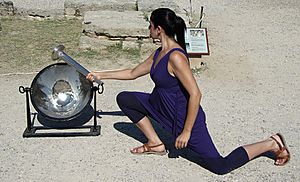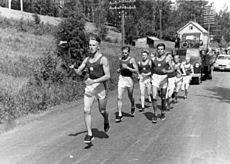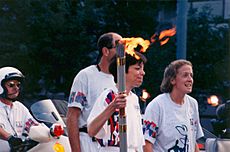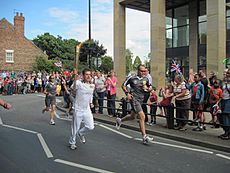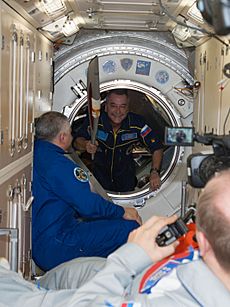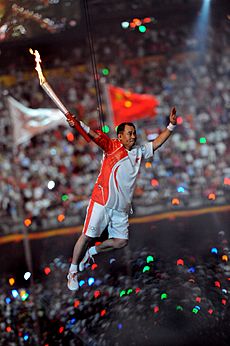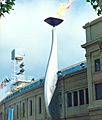Olympic flame facts for kids
The Olympic flame is a special symbol used in the Olympic Games. Before each Olympic Games, the Olympic flame is lit in Olympia, Greece, which is where the ancient Olympic Games took place. This lighting ceremony starts the Olympic torch relay. During the relay, the flame is carried by many people to the city hosting the Games. The relay officially ends when the flame is used to light a large Olympic cauldron during the opening ceremony. The flame then burns in this cauldron throughout the Games, and it is put out during the closing ceremony.
Contents
History of the Olympic Flame
How the Flame Started
The idea of the Olympic flame as a symbol for the modern Olympic Games was first suggested by an architect named Jan Wils. He designed the stadium for the 1928 Summer Olympics in Amsterdam.
The idea for the Olympic flame came from ancient Greece. In ancient times, a sacred fire was kept burning all the time during the ancient Olympics. This fire was on the altar of the sanctuary of Hestia, the goddess of the hearth. In Greek mythology, fire was seen as something divine and special. It was believed that Prometheus stole fire from the gods. Sacred fires were common in many ancient Greek holy places, including Olympia. Every four years, during the Olympic Games, more fires were lit at the temples of Zeus and his wife, Hera. Today, the modern Olympic flame is lit at the spot where the temple of Hera used to be.
When the Olympic fire tradition was brought back for the 1928 Summer Olympics, an employee from Amsterdam's Electric Utility lit the first modern Olympic flame. This happened in the Marathon Tower of the Olympic Stadium in Amsterdam. Since then, the Olympic flame has been a part of every Summer Olympics. The flame was first used in the Winter Olympics at the 1936 Winter Olympics in Garmisch-Partenkirchen.
The Olympic Torch Relay Begins

Unlike the Olympic flame itself, the idea of the Olympic torch relay is quite new. This relay carries the flame from Olympia, Greece to the different places where the Games are held. This tradition did not exist in ancient times. It was started by Carl Diem for the 1936 Summer Olympics in Berlin. These Games were organized by the German government at the time.
For the first Olympic torch relay, the flame traveled over 3,187 kilometers (about 1,980 miles) from Olympia to Berlin. More than 3,300 runners carried the torch over twelve days and eleven nights. There were some small protests along the way in countries like Yugoslavia and Czechoslovakia, but these were stopped by local security. A filmmaker named Leni Riefenstahl later showed this torch relay in her 1938 film Olympia.
Main Ceremonies of the Flame
Lighting the Olympic Flame
The Olympic fire is lit several months before the opening ceremony of the Olympic Games. This special ceremony takes place at the site of the ancient Olympics in Olympia, Greece.
During the ceremony, eleven women, who represent ancient priestesses, perform a celebration at the Temple of Hera. The first torch of the Olympic Torch Relay is lit using the power of the Sun. The Sun's rays are focused by a special curved mirror, which makes the flame appear.
At the start of the ceremony, the Olympic anthem is sung. Then, the national anthem of the country hosting the Olympics is played, followed by the national anthem of Greece. The flags of these countries are also raised.
The Olympic Torch Relay Journey
After the lighting ceremony in Olympia, the Olympic flame first travels around Greece. Then, in a ceremony at the Panathenaic Stadium in Athens, the flame is passed from the previous Olympic host city to the current year's host city.
The Olympic torch relay in the host country ends when the flame is used to light the Olympic cauldron during the opening ceremony. This happens in the main stadium of the Games. The person who carries the torch last is often kept a secret until the very last moment. Over the years, it has become a tradition to choose a famous athlete from the host country, or a former athlete with great achievements, to be the final runner in the Olympic torch relay.
Cool Torch Relays
The Olympic torch travels along routes that represent human achievements. Even though runners still carry the torch most of the time, it has been transported in many different and exciting ways!
- In 1948 and 2012, the fire traveled by boat to cross the English Channel.
- In 2008, it was carried by rowers in Canberra and by a dragon boat in Hong Kong.
- The flame first traveled by airplane in 1952, when it went to Helsinki.
- In 1956, all the torch carriers to Stockholm (where the horse-riding events were held) traveled on horseback.
- In 1976, the flame was even turned into a radio signal and sent from Europe to North America! Heat sensors in Athens detected the flame, and the signal was sent to Ottawa using a satellite. There, it was used to trigger a laser beam to re-light the flame.
- The torch (but not the actual flame) has been taken into space by astronauts in 1996, 2000, and 2013.
- In 2000, the torch was carried underwater by divers near the Great Barrier Reef.
- Other unique ways the torch has traveled include a Native American canoe, a camel, and even the Concorde airplane.
- In 1968, a diver carried the torch above the water across the port of Marseille.
- In 2012, it was carried by boat across Bristol harbor in the UK and on the front of a London Underground train to Wimbledon.
In 2004, the first worldwide torch relay happened. This journey lasted 78 days. The Olympic flame traveled more than 78,000 kilometers (about 48,000 miles) carried by about 11,300 torchbearers. It visited Africa and South America for the first time, went to all previous Olympic cities, and finally returned to Athens for the 2004 Summer Olympics. The 2008 Summer Olympics torch relay went across all six continents where people live before going through China. However, this relay faced protests in cities like London, Paris, and San Francisco. Because of this, in 2009, the International Olympic Committee decided that future torch relays would only happen within the country hosting the Olympics, after the first part in Greece.
Even though this rule started with the 2014 Winter Olympics, the organizers of the 2010 Winter Olympics in Vancouver and the 2012 Summer Olympics in London chose to keep their torch relays mostly within their own countries (Canada and the United Kingdom). The London 2012 torch traveled 8,000 miles across the UK. The Rio 2016 torch traveled 12,000 miles across Brazil.
Lighting the Olympic Cauldron
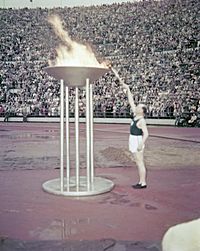
During the opening ceremony, the last person carrying the torch runs towards the cauldron. This cauldron is often placed at the top of a grand staircase. The torch is then used to light the flame in the stadium. This exciting moment, when the Olympic flame is passed from the final torch to the cauldron, officially marks the start of the Games.
Just like being the final runner of the torch relay, lighting the Olympic cauldron is a huge honor. It has also become a tradition to choose famous athletes to do this part of the ceremony.
Once lit, the flame in the Olympic cauldron keeps burning throughout the Games. On the day of the closing ceremony, the flame is finally put out. This symbolizes the official end of the Games.
Memorable Cauldron Lightings
- The first well-known athlete to light the cauldron was Paavo Nurmi, a nine-time Olympic champion. He thrilled the crowd in Helsinki in 1952.
- In 1968, Enriqueta Basilio became the first woman to light the Olympic Cauldron at the Games in Mexico City.
- One of the most amazing cauldron lighting ceremonies happened at the 1992 Summer Olympics in Barcelona. A Paralympic archer named Antonio Rebollo lit the cauldron by shooting a burning arrow over it. The arrow ignited gas rising from the cauldron.
- Two years later, at the 1994 Winter Olympics in Lillehammer, the Olympic fire was brought into the stadium by a ski jumper.
- In Beijing 2008, Li Ning, a Chinese gymnast, seemed to "run" through the air around the Bird's Nest and lit the flame.
- In Vancouver 2010, four athletes—Catriona Le May Doan, Wayne Gretzky, Steve Nash, and Nancy Greene—had the honor of lighting the flame together indoors. Then, Wayne Gretzky moved the flame to an outdoor cauldron.
- Other famous last torchbearers include heavyweight boxing champion Muhammad Ali (1996), Australian Aboriginal runner Cathy Freeman (2000), Brazilian marathon runner Vanderlei de Lima (2016), and South Korean figure skater Yuna Kim (2018).
Sometimes, the people who light the cauldron are not famous, but they represent the spirit of the Olympics.
- Japanese runner Yoshinori Sakai was born in Hiroshima on August 6, 1945, the day the atomic bomb destroyed that city. He symbolized Japan's new beginning after World War II when he opened the 1964 Tokyo Games.
- At the 1976 Games in Montreal, two teenagers—one from the French-speaking part of Canada and one from the English-speaking part—showed the unity of Canada.
- At the 2012 Games in London, Sir Steve Redgrave carried the torch to a group of seven young British athletes. Each of these young athletes lit a small flame on the ground, which then ignited 204 copper petals. These petals came together to form the cauldron for the Games.
Design of Equipment
Olympic Torch Designs
The design of the torch used in the relay changes for each Olympic Games. Torches might be designed to look classic, or to show something special about the host city or country.
- The first Olympic torches in 1936 were made by the Krupp company from wood and metal. Their design was inspired by an olive leaf.
- The unique 1976 torch was made by John L. Saksun's The Queensway Machine Products Ltd.
- Some torches, like those for Albertville in 1992 and Turin in 2006, were designed by famous industrial designers. These design-focused torches have been less popular than the more classic ones. The Turin torch, for example, was criticized for being too heavy for the runners.
The torch for the 1948 London Olympics was designed by architect Ralph Lavers. They were made of a light aluminum alloy, were 47 cm (about 18.5 inches) long, and weighed 960 g (about 2.1 pounds). This classic design, with a long handle and a round bowl on top, was used in many later torch designs. The torch used for the final entry into the stadium and for lighting the cauldron was often a different design. This special torch didn't need to last a long time or be weather-resistant, but it did need a spectacular flame for the opening ceremony.
At the Melbourne Olympics in 1956, the fuel used for the final torch was very bright, but it also hurt the person carrying it. Runners were also burned by the solid-fueled torch for the 1968 Mexico Games. The type of fuel used for the torch has changed over time. Early torches used solid or liquid fuels, including olive oil.
For a very bright display, special firework-like chemicals and even burning metals have been used. Since the Munich Games in 1972, most torches have used a liquid gas like propylene or a mixture of propane and butane. These gases are easy to store, easy to control, and create a bright, glowing flame.
The number of torches made has varied a lot. For example, only 22 torches were made for Helsinki in 1952, but 6,200 were made for the 1980 Moscow Games, and 8,000 for the London 2012 Games. When the flame travels by air, a special version of a miner's safety lamp is used to keep it burning. These lamps are also used during the relay as a backup, in case the main torch goes out. This has happened before some Games, but the torch is simply re-lit, and the relay continues.
Olympic Cauldron Designs
The Olympic cauldron and its base are always designed in a unique and often dramatic way. Their design also connects to how the cauldron is lit during the Opening Ceremony.
Coinage
The Olympic flame has been used as a symbol on many special commemorative coins. For example, a coin was minted in 2002 to celebrate the 50th anniversary of the Helsinki Olympic Games. On one side of the coin, you can see the Olympic flame above the Earth. Finland is the only country highlighted, because it hosted the 1952 Games.
Images for kids
-
Traditional Olympic cauldrons often employ a simple bowl-on-pedestal design, such as the cauldron used for the 1936 Summer Olympics
-
Olympic cauldron during the Vancouver 2010 Olympic Winter Games
-
More artistic and abstract designs for cauldrons, including the 2012 Summer Olympics cauldron, have also been used.
-
Cauldrons can also take on monolithic forms, an example of which being the "cauldron tower" used for the 2014 Winter Olympics
See also
 In Spanish: Llama olímpica para niños
In Spanish: Llama olímpica para niños


